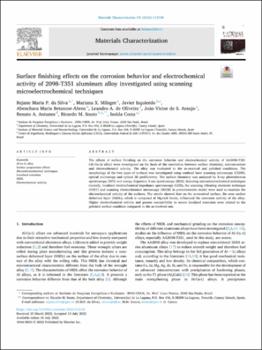Surface finishing effects on the corrosion behavior and electrochemical activity of 2098-T351 aluminum alloy investigated using scanning microelectrochemical techniques R.M.P. da Silva, M.X. Milagre, J. Izquierdo, A.M. Betancor-Abreu, L.A. de Oliveira, J.V.S. Araujo, R.A. Antunes, R.M. Souto, I. Costa
Fecha
2022Resumen
The effects of surface finishing on the corrosion behavior and electrochemical activity of AA2098-T351
(Al–Cu–Li alloy) were investigated on the basis of the correlation between surface chemistry, microstructure
and electrochemical activity. The alloy was evaluated in the as-received and polished conditions. The
morphology of the two types of surfaces was investigated using confocal laser scanning microscopy (CLSM),
optical microscopy and optical 3D profilometry. The surface chemistry was analyzed by X-ray photoelectron
spectroscopy (XPS) and energy dispersive X-ray spectroscopy (EDX). Scanning microelectrochemical techniques
(namely, localized electrochemical impedance spectroscopy (LEIS), the scanning vibrating electrode technique
(SVET) and scanning electrochemical microscopy (SECM) in potentiometric mode) were used to examine the
electrochemical activity of the surfaces. The results showed that on the as-received surface, the near surface
deformed layer (NSDL), which is composed of Mg-rich bands, influenced the corrosion activity of the alloy.
Higher electrochemical activity and greater susceptibility to severe localized corrosion were related to the
polished surface condition compared to the as-received one.






